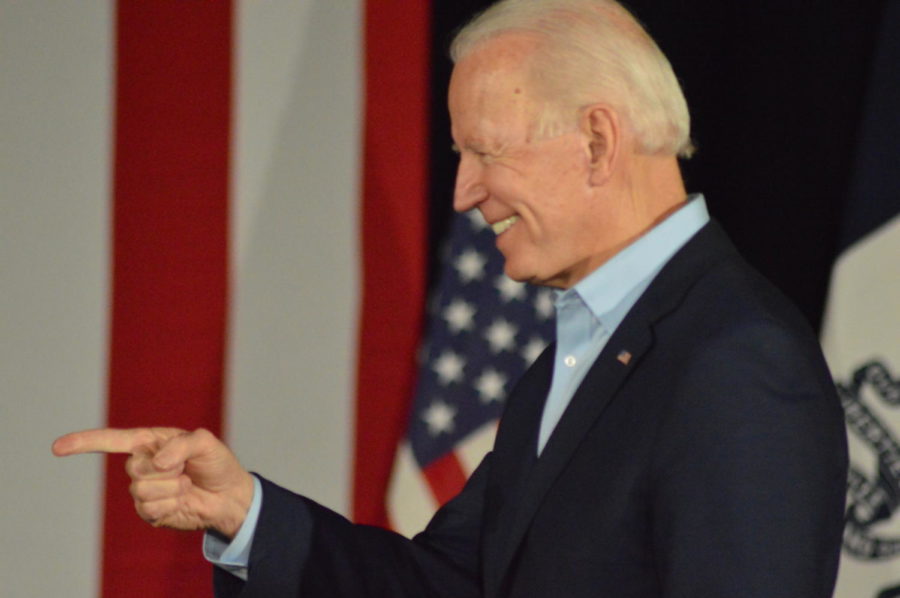Joe Biden’s second executive order as president increases worker protections, minimum wage
Joe Biden has run for president a total of three times, his first time being in 1988 and second in 2008.
January 24, 2021
After more than 10 years, President Joe Biden has signed an executive order to progress toward a $15-an-hour minimum wage for federal employees.
Biden signed the executive order to protect the federal workforce Friday, which also called for eliminating schedule F and restoring collective bargaining powers and worker protections.
“Federal employees have dedicated their careers to serving the American people — and they are worthy of the utmost dignity and respect,” Biden said in a tweet Friday. “Today, I took action to improve the wages, benefits and bargaining rights of federal workers and contractors.”
The current minimum wage in the United States is $7.25 an hour, and it has remained the same since 2009. Peter Orazem, university professor of economics, said wages at the bottom have continued to rise even though the federal minimum wage hasn’t changed in 12 years.
The percentage of people who are paid $7.25 an hour is 2.1 percent of all hourly workers. Within that percentage, nearly half are people 25 years and younger, the Bureau of Labor Statistics reported in 2019. Service occupations had the highest percentage of hourly-paid workers making $7.25 an hour or less, according to the report.
Orazem said there may be some firms in rural areas that pay the minimum wage like in Iowa. But even the urban areas of Iowa tend to start wages at over $10 an hour, according to Orazem.
“A $15 minimum wage is going to bite harder in places that have lower prevailing wages, and those tend to be in rural areas and small towns,” Orazem said. “It will have less of an effect on places that already are $15 per hour.”
Orazem said states on the coasts in favor of raising the minimum wage have to compete against businesses in rural states with lower minimum wages. Mack Shelley, chair of the political science department, said the federal law is supposed to provide a floor in which wages must be above that.
“Need for minimum wage is not always obvious,” Orazem said. “The usual issue is you have firms trying to exploit workers. That might be the case if workers are not mobile, so they can’t easily go out and search for alternative employment so that firms don’t have to compete for labor.”
Even though this floor is supposed to prevent businesses from underpaying their employees, Shelley said there are ways around this in the business industry. Occupation categories that allow wages under the federal law include service, agriculture, retail and full-time students working at a university or in retail. In the service industry, tips shift the responsibility to consumers trying to make up the wage gap.
“Even minimum wage isn’t literally the minimum someone is going to get paid; there are all sorts of loopholes,” Shelley said.
America’s economy took a nosedive when 120 million jobs were lost as a result of the pandemic. Chuck Klapatauskas, junior in mechanical engineering and president of the Young Americans for Freedom at Iowa State, said he expects raising the minimum wage to hurt Americans more than help.
“It is well-intentioned, but I don’t think it is going to work, especially in the middle of America,” Klapatauskas said. “I think corporate America is going to be able to absorb the obvious huge increase from $7.25, but I think it may be the final stutter in this pandemic that shutters small businesses.”
Klapatauskas said the focus right now is to help uplift people who are hurt from the pandemic by putting more money in their pockets, but raising the minimum wage could also hurt the same people in that population because of job loss.
Shelley said there is mixed evidence of the effects of wages on job loss because there are more to business expenses than just paying employees.
“Even though wages cost a big chunk to run a business, there is a lot more to it than just that,” Shelley said.
Klapatauskas said even though some people may benefit from the pay wages, he thinks increasing the minimum wage will hurt students by eliminating jobs like lower-paying summer gigs.
Shelley said in the past when the minimum wage has been increased, it has not been catastrophic. Orazem said wage increases can take place over a period of time to help keep the inflation modest.
“I am suspecting they are not going to want to have a very rapid increase to $15 an hour, atypically to the sectors that have given away most of their jobs to the pandemic,” Orazem said.
Biden signed his executive order Friday along with a second executive order, which included another stimulus package. Shelley said opposition to an increase in wages will come, regardless of if the economy is good or bad.
“The thing all of these circumstances have in common with regard to the minimum wage is just very strong philosophical and practical [values,] like trying to make yourself richer to the point of not paying people as much as they’re worth to work.”







